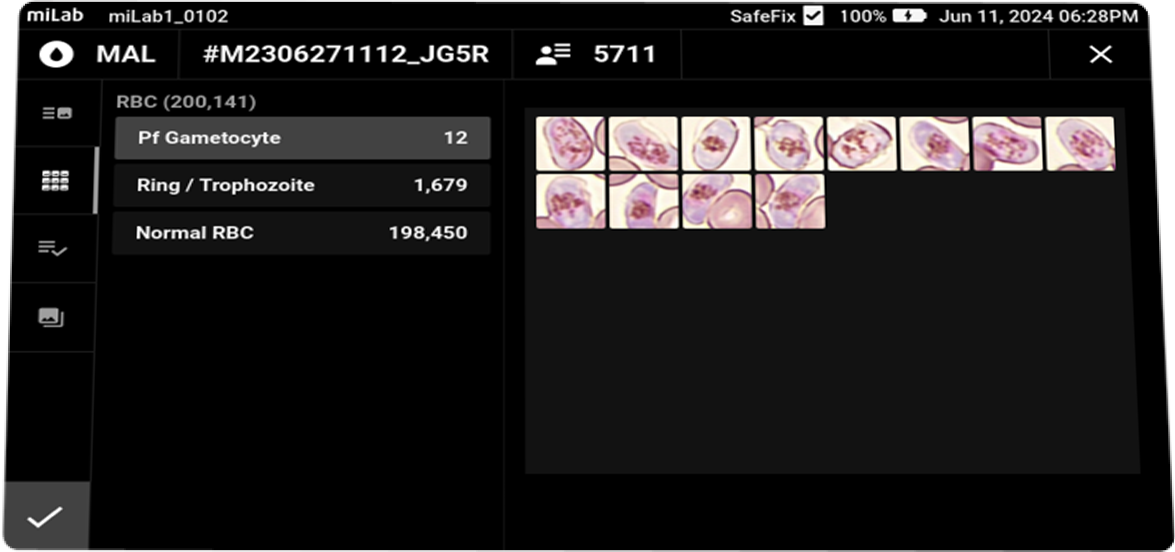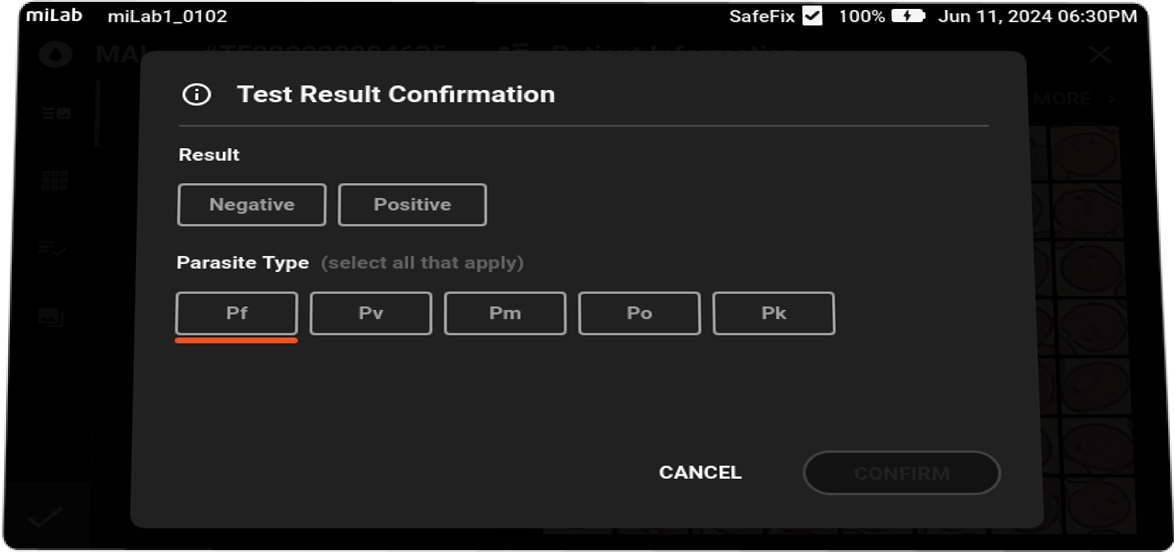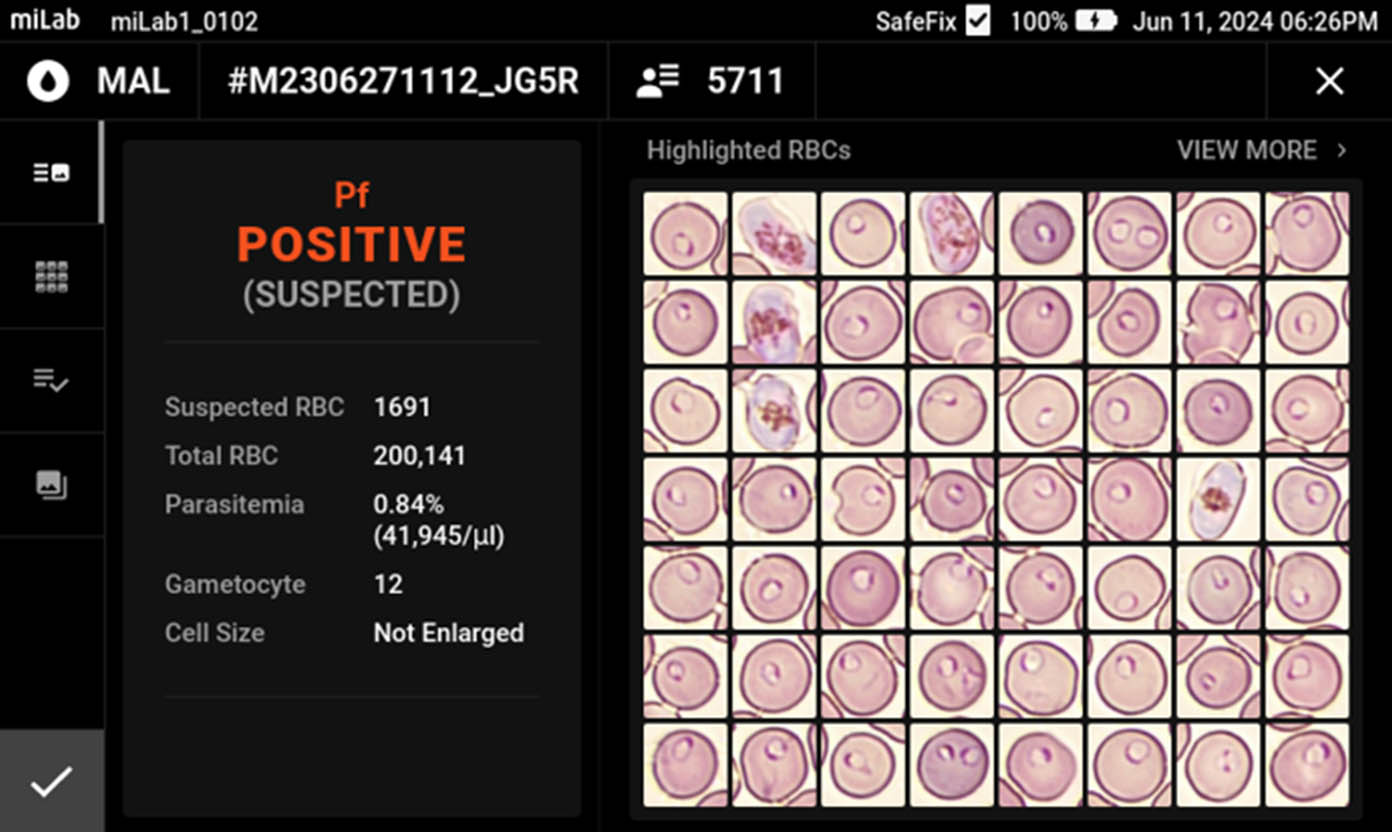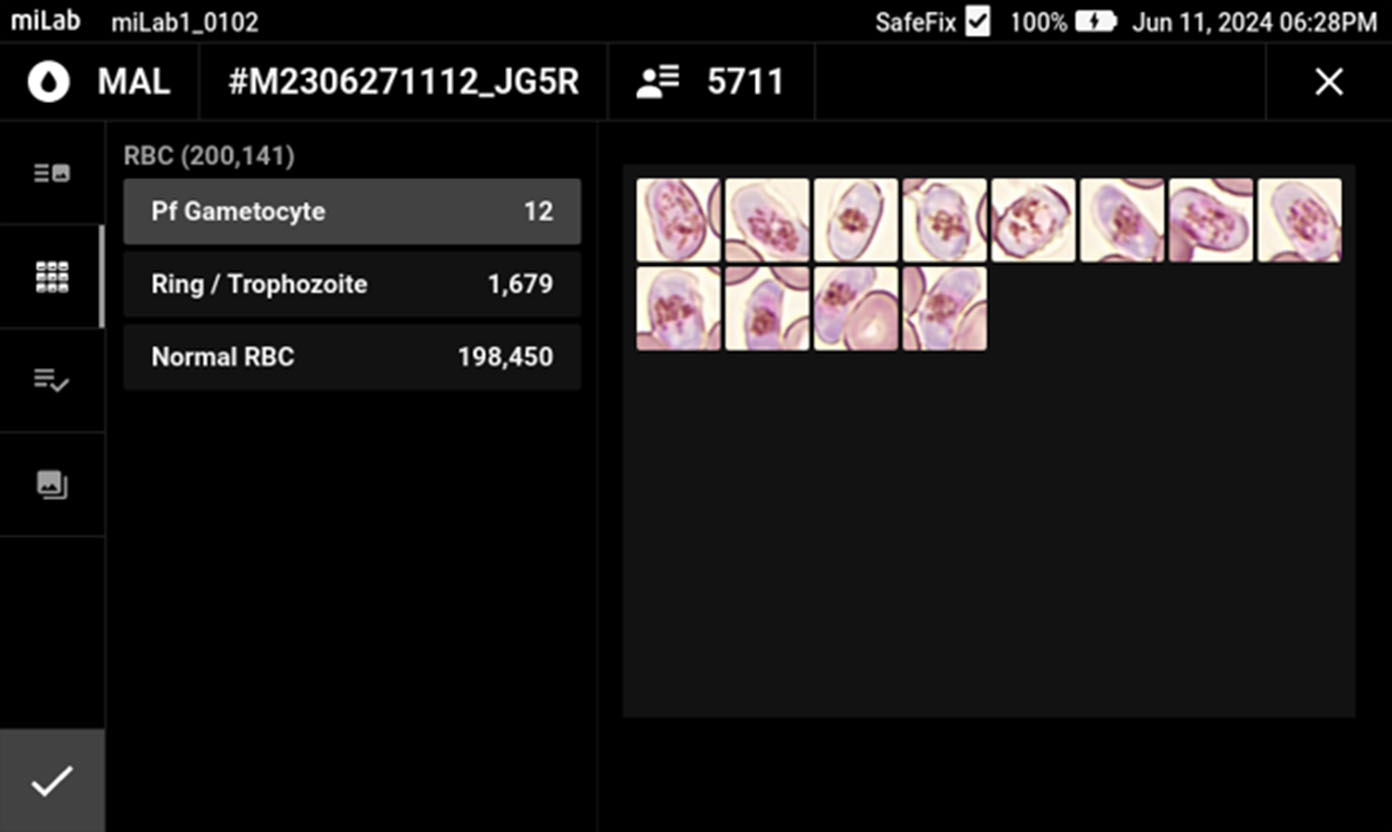본 웹사이트는 사용자에게 최상의 사용자 경험을 제공하기 위해 쿠키를 사용합니다. 쿠키 정보는 브라우저에 저장되어 사용자가 당사 웹사이트로 돌아올 때 사용자를 인식하고, 사용자가 가장 흥미롭고 유용하다고 생각하는 웹사이트 섹션을 당사 팀이 파악하는 데 도움을 주는 등의 기능을 수행합니다.
디지털현미경 기반 말라리아 진단 솔루션, miLab™ MAL
2022년 발간된 UNITAID의 공식 보고서에
Scale-up 단계에 진입할 혁신 제품으로 소개

현미경 진단의 모든 기능을 통합한
가장 발전된 형태의 디지털현미경 플랫폼
말라리아 진단 솔루션 miLab™ MAL은 국제사회로부터 신속진단키트와 현미경 진단이 가지는 한계를 동시에 극복할 혁신적인 말라리아 진단 제품으로 주목받고 있습니다. miLab™ MAL은 2022년 발간된 UNITAID의 공식 보고서*에 Scale-up 단계에 진입할 혁신 제품으로 소개되었습니다.
- * Malaria Diagnostics Market and Technology Landscape, 4th
- 다운받기
- World Malaria Report 2022
- 다운받기
miLab™ MAL은 전세계 말라리아의 종식을 위해
기존 진단 방식의 한계 극복에 집중합니다.
말라리아는 UN, WHO를 비롯한 국제사회가 2030년까지 지구상에서 종식시키기로 선언한 세계 3대 감염질환입니다.
전세계적인 말라리아 이슈의 심각성
* 2022년 기준
말라리아 진단의 주요 이슈와 현재 진단 방식의 한계
접근성 현미경 진단 인프라와 전문 인력 유지 비용 부담으로 수요 대비 Qualified Microscopy Test에 대한 기회 부족 pfhrp2/3 gene deletions pfhrp (Plasmodium falciparum histidine-rich protein) 2/3 유전자 결손 종 출현에 따른 RDT 진단 성능 문제의 지속적 확산 Malaria Imported Cases 코로나 19 팬데믹 종료 후 국경간 인구 이동이 다시 활발해지면서, 말라리아 재유입 및 확산 위험 증가 약제 내성 문제 말라리아 치료제에 대한 약제 내성 이슈 확산으로 말라리아 치료제 효과의 주기적 모니터링 필요성 증가
진단검사실의 정확도와 신속진단키트의 편리성,
신속성을 모두 갖춘 세계 유일의 진단검사 솔루션
- 인프라와 전문 인력 투자 없이도
Qualified Microscopy Test 수행 - 검증된 AI 기술력을 기반으로 Qualified Microscopist 수준의 정확도 높은 진단검사 수행이 가능합니다. 또한, 2시간 가량의 사용법 교육만으로도 제품 사용이 가능할 정도로 사용하기 용이하며, 정밀 판독이 필요할 경우 뷰어를 통해 전문 인력의 원격 지원이 가능합니다.
- pfhrp2/3 gene deletions 이슈와 상관없는 형태학적 진단방식
- 항원항체반응으로 감염여부를 판단하는 신속진단키트와는 달리, miLab은 형태학적 진단 방식을 활용하고 있어 최근 아프리카 중심으로 확산되고 있는 pfhrp2/3 유전자 결손 여부와 상관없이 정확한 진단검사가 가능합니다.
- 말라리아 기생충의 종 구분과
생애주기 단계별 심층 분석 지원 - AI 형태분석을 통해 종 구분과 생애주기 단계 정보 확인할 수 있으며, 이를 기반으로 말라리아 감염 환자에 대한 정확한 치료와 치료 경과 모니터링이 가능합니다.
- 정량적인 Parasitemia 수치 분석 가능
- 전문 인력이 현미경으로 확인하는 개수보다 100배 이상 많은 10~30만개 적혈구 분석을 통해 신뢰도 높은 말라리아 원충 농도 추산이 가능합니다.
사용자의 실제 니즈에 따라
접근성 향상과
워크플로우 개선 측면에서
차별화된 가치를 제공합니다.
- 1. 해외 유입 말라리아 감염발생 비중이 높은 지역 (북미, 유럽, 중동 등)
- 고객 유형
- 자생적으로 말라리아 감염이 발생하지 않는 국가에서 말라리아 진단 검사를 수행해야 하는 국가 지정 진단검사실
- 기대 가치
- 워크플로우 개선을 통한 인건비 절감 및 업무 효율화
- Background
- 미국과 같은 고소득국가에서는 자생적인 말라리아 감염이 발생하지 않기 때문에 말라리아 진단 검사 수요가 많지 않습니다. 그럼에도 불구하고 말라리아는 대부분 국가에서 국가 차원에서 관리하는 감염병이기 때문에 말라리아 진단 검사 역량을 필수적으로 갖춰야 하는 국가 지정 진단검사실이 다수 존재합니다. 게다가 전세계적으로 COVID-19에서 회복되면서 국경간 이동이 확산되고 있어, 말라리아 감염자 유입에 대한 리스크가 증가할 것으로 예상이 됩니다.
- Problem
- 이들 진단검사실에서는 현미경 진단 검사를 위한 전문 인력을 고용해야 하지만, 국가 내 적은 진단 검사 수요 때문에 말라리아 진단에 전문성과 풍부한 경험을 보유한 진단검사 인력은 소수에 불과한 상황입니다. 게다가 COVID-19 이후 전세계적으로 진단검사 인력의 인건비는 빠르게 상승하면서 진단 검사 수요가 적은 분야에서 전문 인력을 고용하는 데에 따른 부담도 증가한 상황입니다. 실제로 유럽과 미국 등 고소득 국가에서는 말라리아 진단 전문 인력의 숫자는 점차 감소하고 있습니다.
- Use-Case
- 말라리아 진단 검사 인력 확보 및 고용에 부담을 느끼고 있는 진단검사실에서는 miLab™ MAL을 도입해 말라리아 진단 검사 역량을 확보할 수 있습니다. 말라리아 진단 검사 인력이 없더라도 마이랩 플랫폼으로 생성된 디지털이미지를 활용해 원격으로 다른 진단검사실에 소속된 말라리아 진단 검사 인력에게 판독을 간편하게 요청할 수 있습니다. 말라리아 진단 검사 인력을 두고 있는 진단검사실에서는 miLab™ MAL을 도입하면서 진단 검사 인력이 결과 판독에 시간을 효율적으로 사용할 수 있습니다. 마이랩 플랫폼이 말라리아 진단을 위한 샘플 프렙과 디지털 이미징, AI 분석까지 모든 과정을 자동으로 수행하기 때문입니다.
- Benefits
- 해당 유형의 고객들은 miLab™ MAL의 도입으로 워크플로우를 개선하고, 이를 통해 인건비 절감과 효율성 향상을 기대할 수 있습니다.
- 2. 자생적인 말라리아 감염 발생건수 비중이 높은 지역 (아프리카, 중남미)
- 고객 유형
- 말라리아 발생건수가 많은 중저소득 국가에서 말라리아 진단 검사를 수행하는 진단검사실
- 기대 가치
- 워크플로우 개선을 통한 검사 결과 신뢰성 제고
- Background
- 말라리아 진단의 골드스탠다드 검사 방식인 현미경 진단 검사는 전문 인력의 숙련도에 따라 품질에 영향을 받습니다. 현미경 진단 검사는 혈액 도말, 염색, 세척 등 8개 이상의 복잡한 단계에 걸쳐 수작업으로 진행되기 때문입니다. 따라서 현미경 진단 검사 품질을 안정적으로 유지하기 위해서는 이를 전문적으로 수행할 수 있는 경험과 기술을 갖춘 전문 인력의 확보가 필수적입니다.
- Problem
- 말라리아 발생건수가 많은 아프리카에 위치한 대부분의 국가들은 현미경 진단 검사에 대한 풍부한 경험과 정확한 전문 지식을 갖춘 전문 인력 확보가 쉽지 않은 상황입니다. 전문 인력 육성을 위한 투자 비용에 대한 부담은 물론이고, 전문 인력을 체계적으로 교육하는 시설과 기반 조차 갖춰져 있지 못하기 때문입니다. 아프리카 내 많은 진단검사실에서 현미경 진단 검사를 수행하고 있지만, 검사 인력의 숙련도에 따라 검사 결과에 대한 편차가 크게 나타나는 등 안정적인 품질 확보에 어려움을 겪고 있습니다. 특히 검사자들의 결과 편차는 실제로는 말라리아 양성이지만, 판단 결과는 말라리아 음성으로 나온 위음성 사례에서 자주 나타나게 됩니다. 말라리아 감염 세포가 있는 걸 확인하기는 쉽지만, 말라리아 감염 세포가 없는 걸 확인하기는 훨씬 더 어렵기 때문입니다.
- Use-Case
- 검사 인력의 숙련도 차이로 말라리아 진단 검사의 품질 관리에 어려움을 겪고 있는 진단검사실은 miLab™ MAL을 도입해 진단 검사의 품질에 대한 신뢰도를 높일 수 있습니다. 특히, 전문 인력이 말라리아 음성으로 판단한 결과에 대해서는 마이랩 말라리아 진단 검사 솔루션으로 한번 더 검사를 수행하여 검사 인력의 결과를 재검증하는 용도로 활용할 수 있습니다. 또한, 마이랩 플랫폼은 모든 분석 결과들이 디지털데이터로 저장되기 때문에 검사 인력을 대상으로 다양한 검체 종류에 대한 판독 훈련을 제공할 수 있습니다.
- Benefits
- 해당 유형의 고객들은 miLab™ MAL 도입으로 검사 인력들의 전문성 향상은 물론, 진단 결과의 신뢰성을 높여 환자에게 보다 정확한 검사 결과와 치료를 제공할 것으로 기대가 됩니다.
- 3. pfhrp2/3 유전자 결손 발생 지역 (아프리카)
- 고객 유형
- pfhrp2/3 유전자 결손이 발생하는 지역에서 신속진단키트를 사용해 말라리아 진단 검사를 수행하는 보건시설
- 기대 가치
- 진단 접근성 향상을 통해 전문 인력이 없는 보건시설에서도 정확한 진단 검사 결과 제공
- Background
- 말라리아 발생건수가 많은 아프리카 국가의 대부분은 현미경 진단 검사보다는 간편한 신속진단키트에 대한 검사 의존도가 높습니다. Global Fund와 같은 국제사회의 공공조달기구 역시 말라리아 진단 검사 도구로 신속진단키트를 구매해 각 국가들에 보급하고 있습니다. 현재 시중에 나와 있는 많은 말라리아 신속 진단검사는 HRP2의 검출을 기반으로 하고 있습니다. 하지만 최근 상당수의 아프리카 국가에서 pfhrp2/3 유전자 결손에 대한 보고가 증가하고 있습니다.
- Problem
- pfhrp2/3 유전자 결손이 있는 기생충의 감염 확산은 신속진단키트에 의존해 말라리아 감염여부를 진단하던 보건시설에서는 진단 정확성에 큰 위협을 가하고 있습니다. pfhrp2/3 유전자 결손을 가진 기생충은 신속진단키트로는 감염여부가 확인이 되지 않기 때문에 적절히 치료되지 못하고 살아남아 빠른 속도로 확산되고 있습니다. 신속진단키트에 대한 신뢰도가 낮아진 상황에서 말라리아 진단을 위한 기술적 대안은 현미경 진단 역량을 확보하는 것입니다. 그렇지만 현미경 진단 역량 확보를 위해서는 인프라 구축, 전문 인력 육성 등이 수반되면서 자본 투자가 필요합니다.
- Use-Case
- pfhrp2/3 유전자 결손이 확산되고 있는 지역에 위치한 보건시설에서는 결과를 신뢰하기 어려운 신속진단키트를 사용하는 대신 miLab™ MAL을 도입해 말라리아 진단 검사서비스를 유지할 수 있습니다. miLab™ MAL은 간단한 사용법 교육을 통해 사용이 가능하기 때문에 기존에 현미경 진단 검사에 대한 전문성이 없는 현지 보건인력들 역시 활용하기 용이합니다.
- Benefits
- 해당 유형의 고객들은 miLab™ MAL 도입으로 전문 현미경 검사 인력을 확보하지 않고도, 기존 인력만으로도 신뢰할 수 있는 현미경 진단 솔루션을 환자들에게 제공할 것으로 기대가 됩니다.
- Examples
- 콩고민주공화국, 에티오피아 등 중앙아프리카
- 4. 혼합감염 사례 발생 지역 (중남미, 동남아 등)
- 고객 유형
- 복수의 말라리아 기생충 감염 가능성이 존재하는 지역에서 신속진단키트를 사용해 말라리아 진단 검사를 수행하는 보건시설
- 기대 가치
- 진단 접근성 향상으로 정확한 진단 검사 결과 제공 및 Surveillance 체계 강화
- Background
- 말라리아는 아프리카 국가 외에도 중남미, 아시아 등 다양한 지역에서도 발생하고 있습니다. 아프리카 국가에서 발견되는 말라리아 기생충은 주로 P.falciparum이지만, 중남미, 아시아 등 지역에서는 P.vivax, P.knowlesi, P.ovale, P.malariae 등 다양한 종이 존재합니다. 말라리아 기생충 종에 따라서 생물학적 특성에 차이가 존재하기 때문에, 감염 시 증상은 물론이고 종별로 말라리아 치료와 진단 방법 등에서 차이가 있습니다. 현재 전세계적으로 30여개국 이상에서 2개 종 이상의 말라리아가 발견되고 있으며, 기존에 P.falciparum만 발견되던 국가에서 다른 기생충 종의 유입 사례도 보고되고 있습니다.
- Problem
- 신속진단키트의 경우 P.falciparum나 P.vivax 같이 발생건수가 많은 단일 종에 대한 감염여부 확인에는 효과적이지만, 2개 종 이상의 혼합감염이나 다른 종에 대한 진단 검사에 활용하지 못한다는 한계가 존재합니다. 따라서 2개 종 이상이 발견되는 국가에서는 신속진단키트의 항원항체검사의 진단 결과에 대한 신뢰도가 떨어지게 됩니다. 특히, 인구의 이동이 많은 국경 지역 혹은 정확한 진단 검사가 어려운 어려운 밀림 지역에서 새로운 말라리아 기생충 종의 유입 위험성이 높습니다.
- Use-Case
- 복수의 말라리아 기생충 감염 가능성이 존재하는 지역에서는 보건시설에서도 miLab™ MAL 도입으로 기생충 종의 형태학적 특징까지 확인할 수 있습니다.
- Benefits
- 해당 유형의 고객들은 miLab™ MAL의 도입으로 환자가 감염된 말라리아 종을 정확하게 구분할 수 있을 것으로 기대하고 있습니다. 또한, 국가 차원의 말라리아 감염병 Surveilance 체계 운영 관점에서도 국경 접점에서 새로운 종의 유입을 빠르게 확인할 수 있을 것으로 기대가 됩니다.
- 5. 특수 사례 (Special Situation)
말라리아는 전세계 84개국에서 광범위하게 발생하는 감염질환으로, 군대, 선박, 열대우림, 분쟁 지역, 난민 캠프 등 다양한 특수 환경에서도 말라리아 감염의 위험이 존재합니다.
miLab™ MAL은 인프라와 전문 인력이 부족한 특수 상황에서도 정확하고 신속한 말라리아 진단이 가능한 디지털현미경 플랫폼입니다. 말라리아 진단이 필요한 곳이라면 어떤 환경에서든지 손쉽게 활용할 수 있도록 지속적으로 제품을 발전시켜나가고 있습니다.
특수 환경에서의 miLab™ MAL 사용에 대해 궁금한 점이 있으시면 연락주세요.
Check
200,000 RBCs
in 15 min.
- miLab™ MAL Specification
- Sample Preparation
Staining method Romanowsky Sample type Venous or finger-prick blood Sample volume 5μl
- Imaging
Focusing Multi-focus images acquired
(5 z-stack layers)Image count 50x magnification
Acquires max. of 300,000 RBCS
- Analysis
Species suggestions Plasmodium falciparum (Pf)
Plasmodium vivax (Pv)
Positive results are suggested for other Plasmodium species upon infection.Stages suggestions Gametocyte, Schizont, Ring / Trophozoite Count Suspected RBC, Total RBC Parasitemia level %, Suspected RBC/μl Viewing Functions
(miLab™ and miLab Viewer™)User Result Confirmation
Cell View (Species and Stages Classification and images downioad)
Field View
Cell Reclassification (Available from miLab Viewer)
Report (Available from miLab Viewer in PDF and Print-out)
- Total Test Time
Avg. 15 mins
- Product Code
Product Code miLab™ Platform DMLA miLab™ Cartridge MAL CMAA miLab Viewer™ SMVA SafeFix™ CSFA miLab™ Slide Case ASCA



















에티오피아 임상 현장에서 현지 전문 인력들이 찾아내지 못한 말라리아 감염 환자를 마이랩 플랫폼으로 찾아낸 사례들이 많이 있습니다. 게다가 마이랩은 사용하기 쉽고 간단하기 때문에 임상 현장에서 꼭 필요로 하던 제품입니다.
by Cristian Koepfli, Ph.D.
Assistant Professor of University of Notre Dame
P.falciparum 진단 시 민감도 94.3%, 특이도 94%, P.vivax 진단 시 민감도 97%, 특이도 97.6%.
에티오피아에서는 52건의 P.falciparum 감염 중 pfhrp2/3 유전자 결손이 있는 51개 케이스에 대해 양성 진단
(A digital microscope for the diagnosis of Plasmodium falciparum and Plasmodium vivax, including P. falciparum with hrp2/hrp3 deletion. Ewnetu et al., PLOS Global Public Health (2024))
다운받기